Effect of Foliar Applied Acetylsalicilic Acid on Wheat (Triticum aestivum L.) under Field Conditions
Abstract
1. Introduction
2. Materials and Methods
2.1. Trial Conditions
2.2. Experimental Set-up
2.3. Characteristics of the Preparation
2.4. Spraying Parameters
2.5. Observations
2.6. Weather Conditions
2.7. Statistical Analysis
3. Results
3.1. General Influence of Acetylsalicylic Acid on Wheat
3.2. Plant Height (PH) and Ear Length (EL)
3.3. Chlorophyll in the Flag Leaf (CH)
3.4. Number of Grains (NG) and Mass of a Thousand Grains (MTG)
3.5. Grain Density (GD) and Grain Hardness (GH)
3.6. Yield (Y)
3.7. Sedimentation Index (SI), Protein (P), Gluten (G) and Starch (S) in Grains
4. Discussion
5. Conclusions
Author Contributions
Funding
Acknowledgments
Conflicts of Interest
References
- Hellin, J.; Shiferaw, B.; Cairns, J.E.; Reynolds, M.P.; Ortiz-Monasterio, I.; Bänziger, M.; Sonder, K.; La Rovere, R. Climate change and food security in the developing world: Potential of maize and wheat research to expand options for adaptation and mitigation. J. Dev. Agric. Econ. 2012, 4, 311–321. [Google Scholar] [CrossRef]
- Shiferaw, B.; Smale, M.; Braun, H.J.; Duveiller, E.; Reynolds, M.; Muricho, G. Crops that feed the world 10. Past successes and future challenges to the role played by wheat in global food security. Food Secur. 2013, 5, 291–317. [Google Scholar] [CrossRef]
- Monneveux, P.; Jing, R.; Misra, S. Phenotyping for drought adaptation in wheat using physiological traits. Front. Physiol. 2012, 3, 429. [Google Scholar] [CrossRef] [PubMed]
- Semenov, M.A. Impacts of climate change on wheat in England and Wales. J. R. Soc. Interface 2009, 6, 343–350. [Google Scholar] [CrossRef] [PubMed]
- Semenov, M.A.; Stratonovitch, P.; Alghabari, F.; Gooding, M.J. Adapting wheat in Europe for climate change. J. Cereal Sci. 2014, 59, 245–256. [Google Scholar] [CrossRef] [PubMed]
- Thaler, S.; Eitzinger, J.; Trnka, M.; Dubrovsky, M. Impacts of climate change and alternative adaptation options on winter wheat yield and water productivity in a dry climate in Central Europe. J. Agric. Sci. 2012, 150, 537–555. [Google Scholar] [CrossRef]
- Dixon, J.; Nalley, L.; Kosina, P.; La Rovere, R.; Hellin, J.; Aquino, P. Adoption and economic impact of improved wheat varieties in the developing world. J. Agric. Sci. 2006, 144, 489–502. [Google Scholar] [CrossRef][Green Version]
- Farooq, S.; Shahid, M.; Khan, M.B.; Hussain, M.; Farooq, M. Improving the productivity of bread wheat by good management practices under terminal drought. J. Agron. Crop Sci. 2015, 201, 173–188. [Google Scholar] [CrossRef]
- Duggan, B.L.; Domitruk, D.R.; Fowler, D.B. Yield component variation in winter wheat grown under drought stress. Can. J. Plant Sci. 2000, 80, 739–745. [Google Scholar] [CrossRef]
- Bafeel, S.O.; Ibrahim, M.M. Antioxidants and accumulation of α-tocopherol induce chilling tolerance in Medicago sativa. Int. J. Agric. Biol. 2008, 10, 593–598. [Google Scholar]
- Yao, X.; Chu, J.; Wang, G. Effects of selenium on wheat seedlings under drought stress. Biol. Trace Elem. Res. 2009, 130, 283–290. [Google Scholar] [CrossRef] [PubMed]
- Winter, G.; Todd, C.D.; Trovato, M.; Forlani, G.; Funck, D. Physiological implications of arginine metabolism in plants. Front. Plant Sci. 2015, 6, 534. [Google Scholar] [CrossRef] [PubMed]
- Ahmad, I.; Basra, S.M.A.; Wahid, A. Exogenous application of ascorbic acid, salicylic acid and hydrogen peroxide improves the productivity of hybrid maize at low temperature stress. Int. J. Agric. Biol. 2014, 16, 825–830. [Google Scholar]
- Ali, Q.; Anwar, F.; Ashraf, M.; Saari, N.; Perveen, R. Ameliorating effects of exogenously applied proline on seed composition, seed oil quality and oil antioxidant activity of maize (Zea mays L.) under drought stress. Int. J. Mol. Sci. 2013, 14, 818–835. [Google Scholar] [CrossRef]
- Ashraf, M.; Foolad, M. Roles of glycine betaine and proline in improving plant abiotic stress resistance. Environ. Exp. Bot. 2007, 59, 206–216. [Google Scholar] [CrossRef]
- Sotiropoulos, T.E.; Dimassi, K.N.; Therios, I.N. Effects of L-arginine and L-cysteine on growth, and chlorophyll and mineral contents of shoots of the apple rootstock EM 26 cultured in vitro. Biol. Plant. 2005, 49, 443–445. [Google Scholar] [CrossRef]
- Hassanein, R.A.; El-Khawas, S.A.; Ibrahim, S.K.; El-Bassiouny, H.M.; Mostafa, H.A.; Abdel-Monem, A.A. Improving the thermo tolerance of wheat plant by foliar application of arginine or putrescine. Pak. J. Bot. 2013, 45, 111–118. [Google Scholar]
- Venkatesh, J.; Park, S.W. Role of L-ascorbate in alleviating abiotic stresses in crop plants. Bot. Stud. 2014, 55, 38. [Google Scholar] [CrossRef]
- Yang, X.; Cui, X.; Zhao, L.; Guo, D.; Feng, L.; Wei, S.; Zhao, C.; Huang, D. Exogenous glycine nitrogen enhances accumulation of glycosylated flavonoids and antioxidant activity in lettuce (Lactuca sativa L.). Front. Plant Sci. 2017, 8, 2098. [Google Scholar] [CrossRef]
- Xiaochuang, C.; Chu, Z.; Lianfeng, Z.; Junhua, Z.; Hussain, S.; Lianghuan, W.; Qianyu, J. Glycine increases cold tolerance in rice via the regulation of N uptake, physiological characteristics, and photosynthesis. Plant Physiol. Biochem. 2017, 112, 251–260. [Google Scholar] [CrossRef]
- Waqas, M.A.; Khan, I.; Akhter, M.J.; Noor, M.A.; Ashraf, U. Exogenous application of plant growth regulators (PGRs) induces chilling tolerance in short-duration hybrid maize. Environ. Sci. Pollut. Res. 2017, 24, 11459–11471. [Google Scholar] [CrossRef] [PubMed]
- Matysiak, K.; Miziniak, W.; Kaczmarek, S.; Kierzek, R. Herbicides with natural and synthetic biostimulants in spring wheat. Ciência Rural 2018, 48, 1–10. [Google Scholar] [CrossRef]
- Matysiak, K.; Kierzek, R.; Siatkowski, I.; Kowalska, J.; Krawczyk, R. Effect of exogenous application of amino acids L-Arginine and Glycine on maize under temperature stress. Agronomy 2020, 10, 769. [Google Scholar] [CrossRef]
- Hammad, S.A.; Ali, O.A. Physiological and biochemical studies on drought tolerance of wheat plants by application of amino acids and yeast extract. Ann. Agric. Sci. 2014, 59, 133–145. [Google Scholar] [CrossRef]
- Ghazijahani, N.; Hadavi, E.; Jeong, B.R. Foliar sprays of citric acid and salicylic acid alter the pattern of root acquisition of some minerals in sweet basil (Ocimum basilicum L.). Front. Plant Sci. 2014, 5, 573. [Google Scholar] [CrossRef]
- Rivas-San Vicente, M.; Plasencia, J. Salicylic acid beyond defence: Its role in plant growth and development. J. Exp. Bot. 2011, 62, 3321–3338. [Google Scholar] [CrossRef]
- Raskin, I. Role of salicylic acid in plants. Annu. Rev. Plant Biol. 1992, 43, 439–463. [Google Scholar] [CrossRef]
- Lopez-Bucio, J.; Nieto-Jacobo, M.I. Organic acid metabolism in plants: From adaptive physiology to transgenic varieties for cultivation in extreme soils. Plant Sci. 2000, 160, 1–13. [Google Scholar] [CrossRef]
- Malamy, J.; Klessig, D.F. Salicylic acid and plant disease resistance. Plant J. 1992, 2, 643–654. [Google Scholar] [CrossRef]
- Raskin, I. Salicylate, a new plant hormone. Plant Physiol. 1992, 99, 799. [Google Scholar] [CrossRef]
- Hayat, Q.; Hayat, S.; Irfan, M.; Ahmad, A. Effect of exogenous salicylic acid under changing environment: A review. Environ. Exp. Bot. 2010, 68, 14–25. [Google Scholar] [CrossRef]
- Popova, L.; Pancheva, T.; Uzunova, A. Salicylic acid: Properties, biosynthesis and physiological role. Bulg. J. Plant Physiol. 1997, 23, 85–93. [Google Scholar]
- Bandurska, H.; Stroiński, A. The effect of salicylic acid on barley response to water deficit. Acta Physiol. Plant. 2005, 27, 379–386. [Google Scholar] [CrossRef]
- Gondor, O.K.; Janda, T.; Soós, V.; Pál, M.; Majláth, I.; Adak, M.K.; Balázs, E.; Szalai, G. Salicylic acid induction of flavonoid biosynthesis pathways in wheat varies by treatment. Front. Plant Sci. 2016, 7, 1447. [Google Scholar] [CrossRef]
- Gharib, F.A. Effect of salicylic acid on the growth, metabolic activities and oil content of basil and marjoram. Int. J. Agric. Biol. 2006, 4, 485–492. [Google Scholar]
- Senaratna, T.; Touchell, D.; Bunn, E.; Dixon, K. Acetyl salicylic acid (Aspirin) and salicylic acid induce multiple stress tolerance in bean and tomato plants. Plant Growth Regul. 2000, 30, 157–161. [Google Scholar] [CrossRef]
- Khoshbakht, D.; Asgharei, M.R. Influence of foliar-applied salicylic acid on growth, gas-exchange characteristics, and chlorophyll fluorescence in citrus under saline conditions. Photosynthetica 2015, 53, 410–418. [Google Scholar] [CrossRef]
- Khan, N.; Zandi, P.; Ali, S.; Mehmood, A.; Adnan Shahid, M.; Yang, J. Impact of salicylic acid and PGPR on the drought tolerance and phytoremediation potential of Helianthus annus. Front. Microbiol. 2018, 9, 2507. [Google Scholar] [CrossRef]
- Sakhabutdinova, A.R.; Fatkhutdinova, D.R.; Bezrukova, M.V.; Shakirova, F.M. Salicylic acid prevents the damaging action of stress factors on wheat plants. Bulg. J. Plant Physiol. 2003, 21, 314–319. [Google Scholar]
- El-Shraiy, A.M.; Hegazi, A.M. Effect of acetylsalicylic acid, indole-3-bytric acid and gibberellic acid on plant growth and yield of Pea (Pisum sativum L.). Aust. J. Basic Appl. Sci. 2009, 3, 3514–3523. [Google Scholar]
- Erdal, S.; Aydın, M.; Genisel, M.; Taspınar, M.S.; Dumlupinar, R.; Kaya, O.; Gorcek, Z. Effects of salicylic acid on wheat salt sensitivity. Afr. J. Biotechnol. 2011, 10, 5713–5718. [Google Scholar] [CrossRef]
- Moharekar, S.T.; Lokhande, S.D.; Hara, T.; Tanaka, R.; Tanaka, A.; Chavan, P.D. Effect of salicylic acid on chlorophyll and carotenoid contents of wheat and moong seedlings. Photosynthetica 2003, 41, 315. [Google Scholar] [CrossRef]
- Pancheva, T.V.; Popova, L.P.; Uzunova, A.N. Effects of salicylic acid on growth and photosynthesis in barley plants. J. Plant Physiol. 1996, 149, 57–63. [Google Scholar] [CrossRef]
- Çanakçi, S.; Munzuroğlu, Ö. Effects of salicylic acid on growth and chlorophyll destruction of some plant tissues. World J. Agric. Res. 2009, 5, 577–581. [Google Scholar]
- Çanakçi, S. Effects of salicylic acid on fresh weight change, chlorophyll and protein amounts of radish (Raphanus sativus L.) seedlings. J. Biol. Sci. 2008, 8, 431–435. [Google Scholar] [CrossRef]
- Çanakçi, S. Effects of salicylic acid on growth, biochemical constituents in pepper (Capsicum annuum L.) seedlings. Pak. J. Biol. Sci. 2011, 14, 300–304. [Google Scholar] [CrossRef] [PubMed][Green Version]
- Iwańska, M.; Stępień, M. The effect of soil and weather conditions on yields of winter wheat in multi-environmental trials. Biom. Lett. 2019, 56, 263–279. [Google Scholar] [CrossRef]
- R Core Team. R: A Language and Environment for Statistical Computing; R Foundation for Statistical Computing: Vienna, Austria, 2019; Available online: https://www.R-project.org/ (accessed on 6 May 2020).
- Kaydan, D.; Yagmur, M.; Okut, N. Effects of salicylic acid on the growth and some physiological characters in salt stressed wheat (Triticum aestivum L.). Tarim Bilimleri Dergisi 2007, 13, 114–119. [Google Scholar]
- Yu, H.; Zhang, Q.; Sun, P.; Song, C. Impact of droughts on winter wheat yield in different growth stages during 2001–2016 in Eastern China. Int. J. Disaster Risk Sci. 2018, 9, 376–391. [Google Scholar] [CrossRef]
- Cogato, A.; Meggio, F.; De Antoni Migliorati, M.; Marinello, F. Extreme Weather Events in Agriculture: A Systematic Review. Sustainability 2019, 11, 2547. [Google Scholar] [CrossRef]
- Fleming, T.R.; Fleming, C.C.; Levy, C.C.; Repiso, C.; Hennequart, F.; Nolasco, J.B.; Liu, F. Biostimulants enhance growth and drought tolerance in Arabidopsis thaliana and exhibit chemical priming action. Ann. Appl. Biol. 2019, 174, 153–165. [Google Scholar] [CrossRef]
- Bulgari, R.; Franzoni, G.; Ferrante, A. Biostimulants application in horticultural crops under abiotic stress conditions. Agronomy 2019, 9, 306. [Google Scholar] [CrossRef]
- Yildirim, E.; Turan, M.; Guvenc, I. Effect of foliar salicylic acid applications on growth, chlorophyll, and mineral content of cucumber grown under salt stress. J. Plant Nutr. 2008, 31, 593–612. [Google Scholar] [CrossRef]
- Hayat, S.; Ali, B.; Ahmad, A. Salicylic acid: Biosynthesis, metabolism and physiological role in plants. In Salicylic Acid: A Plant Hormone; Springer: Dordrecht, The Netherlands, 2007; pp. 1–14. [Google Scholar]
- Janda, T.; Szalai, G.; Tari, I.; Paldi, E. Hydroponic treatment with salicylic acid decreases the effects of chilling injury in maize (Zea mays L.) plants. Planta 1999, 208, 175–180. [Google Scholar] [CrossRef]
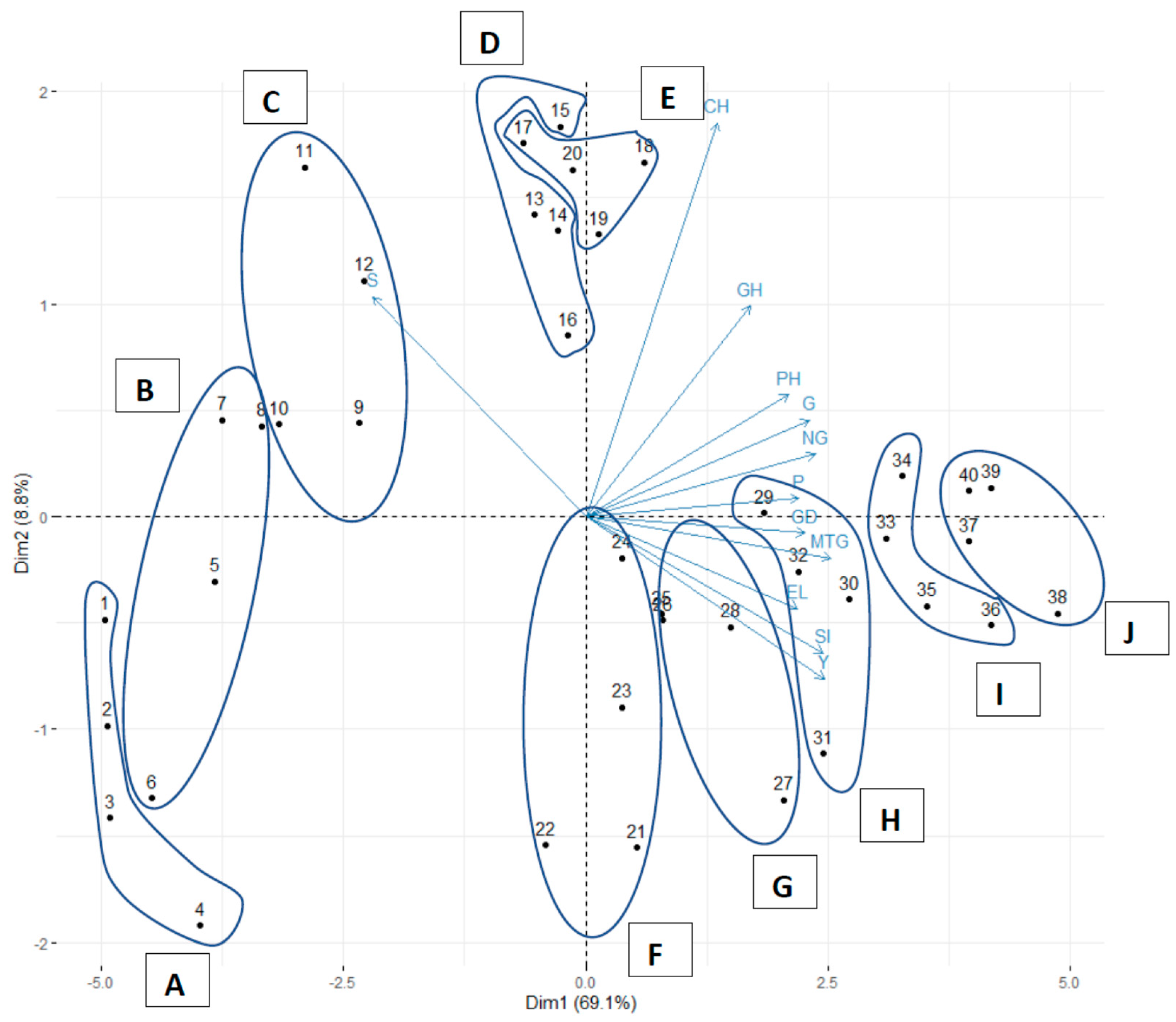
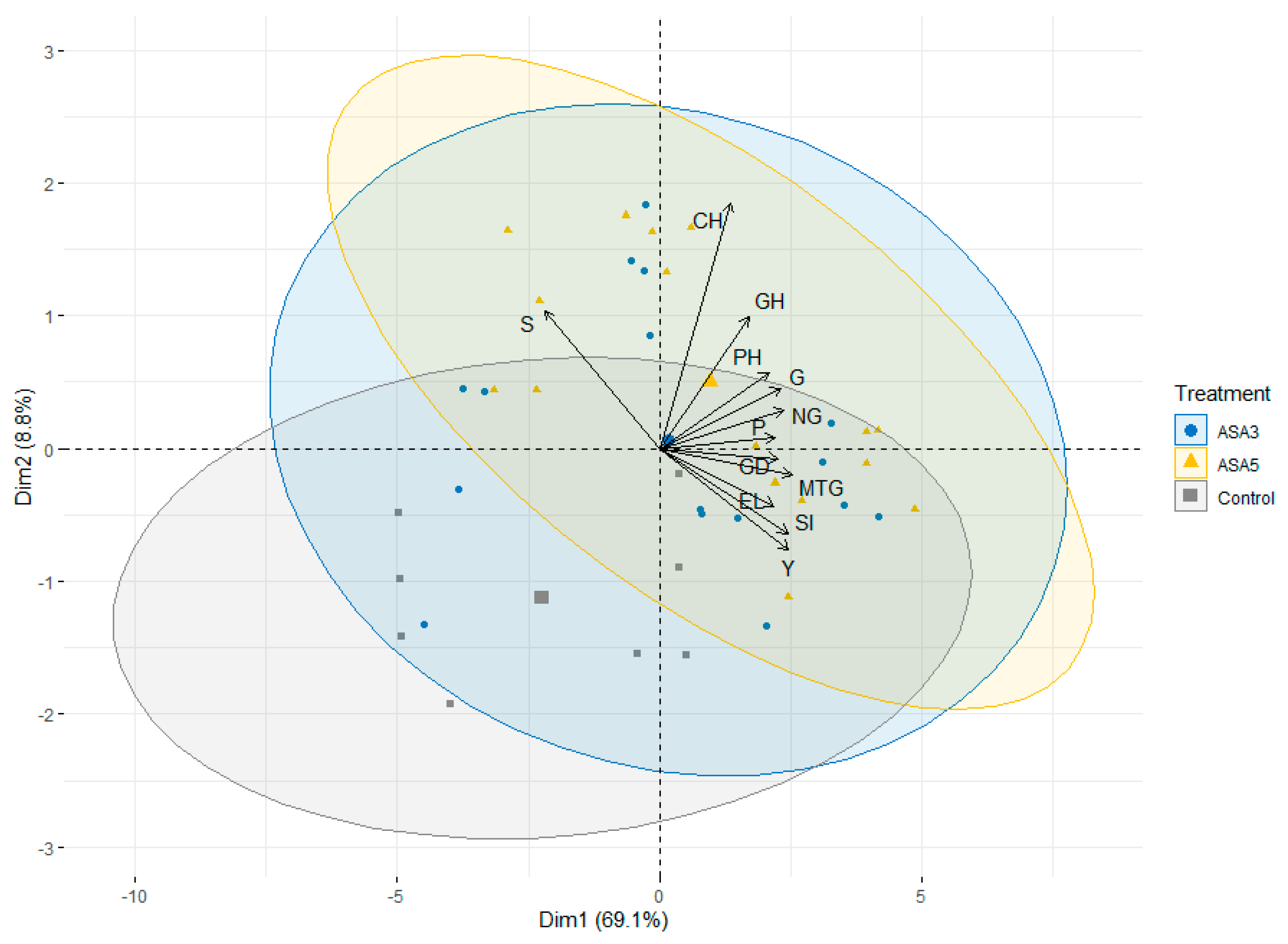
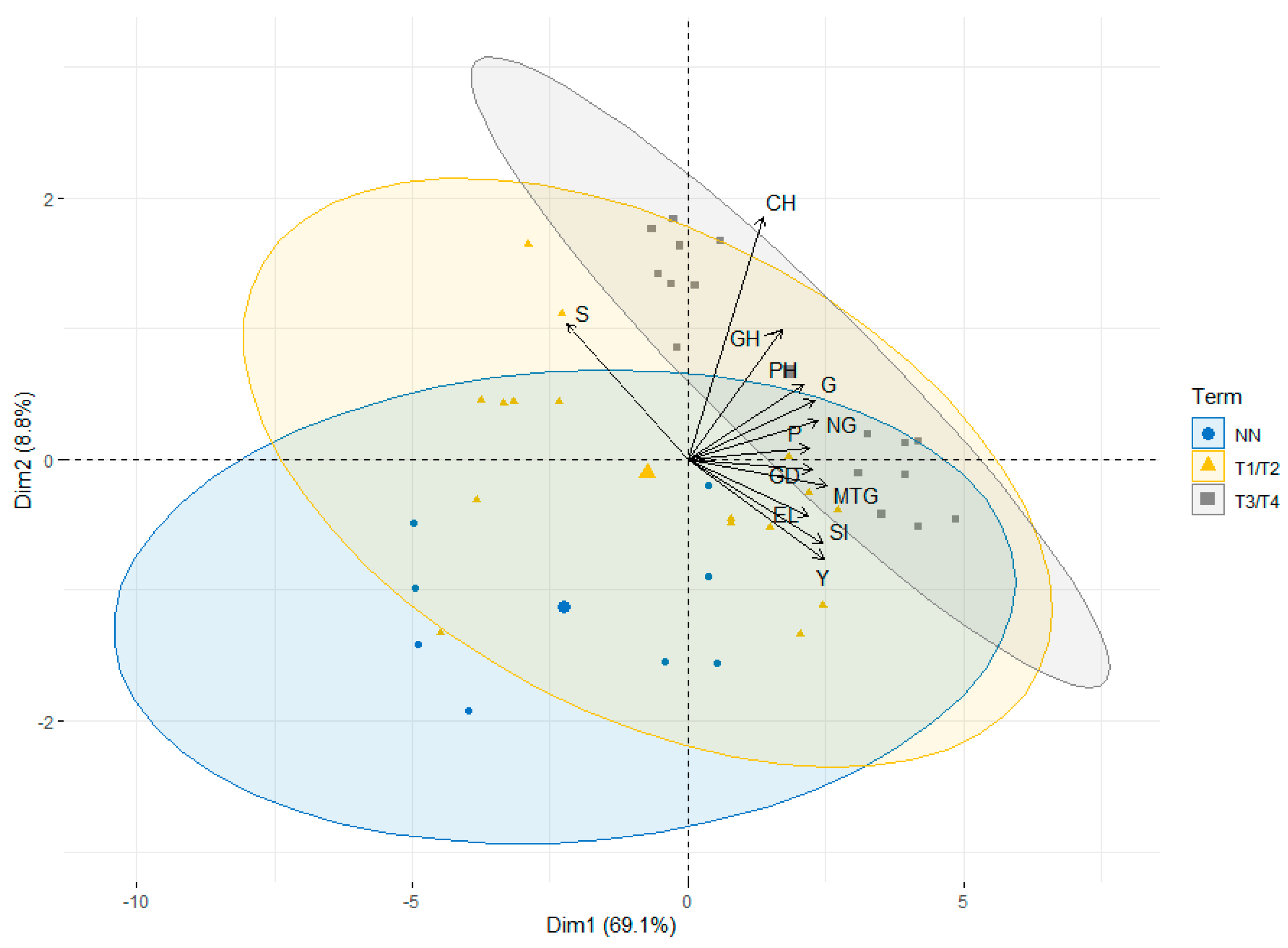
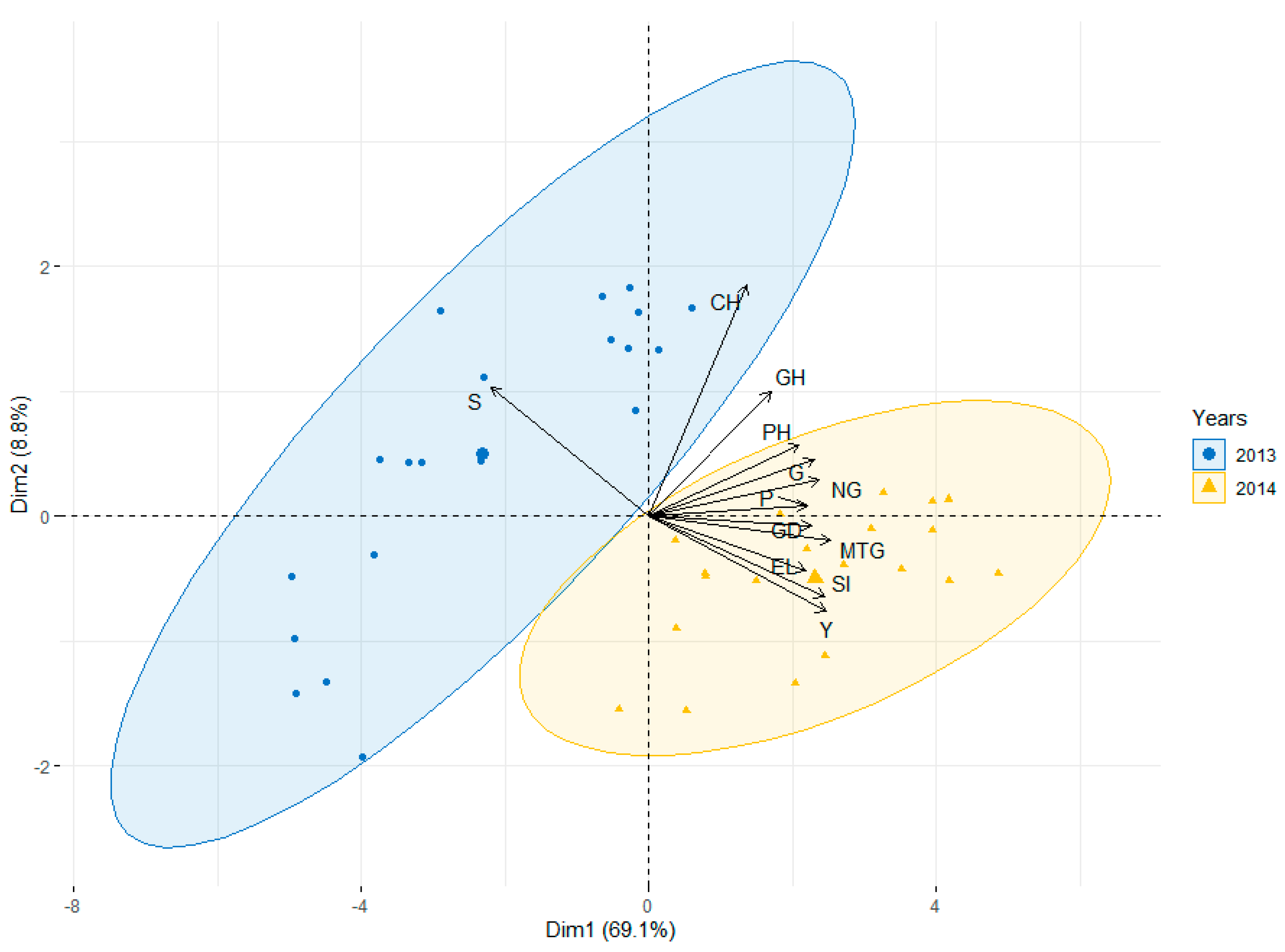
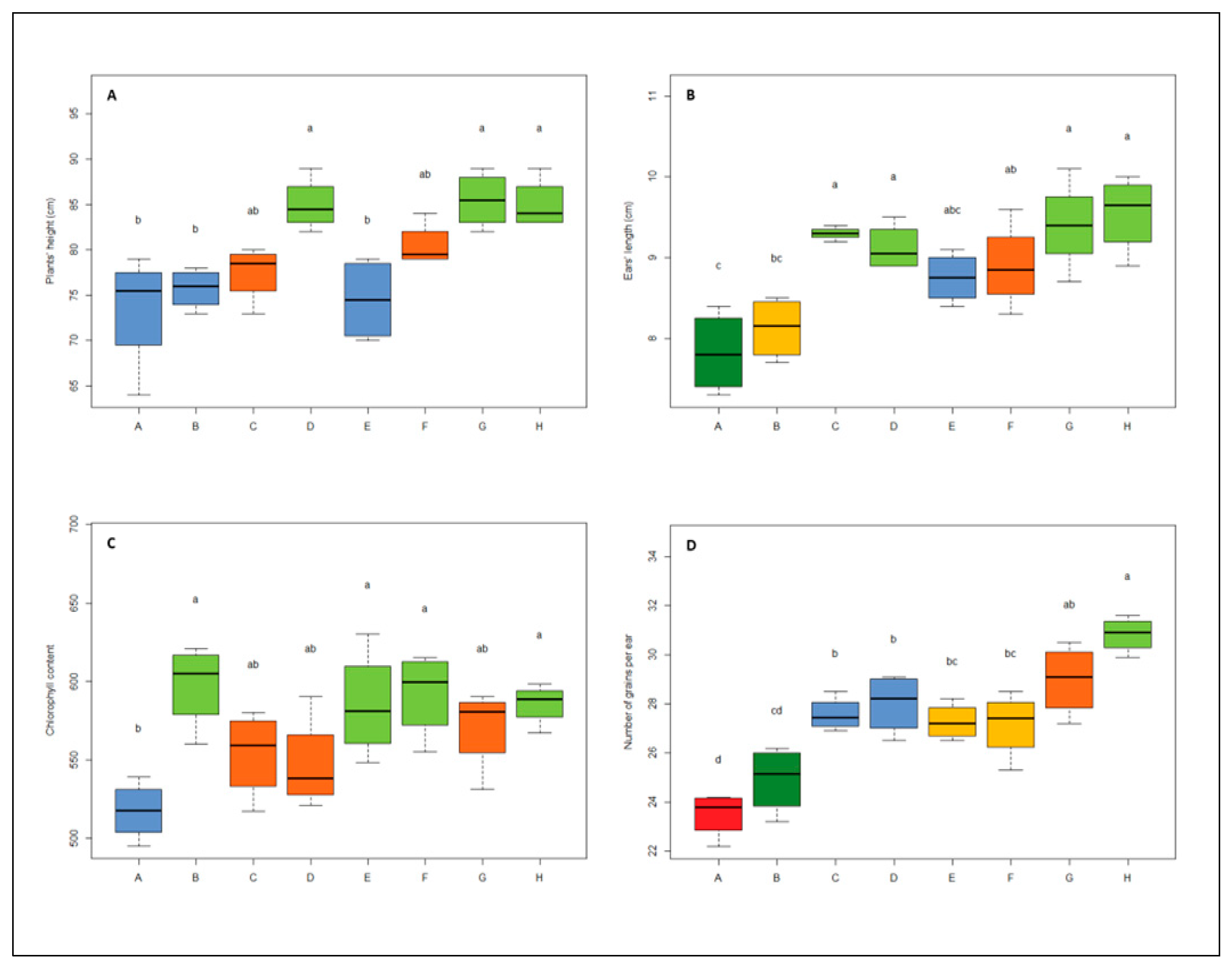
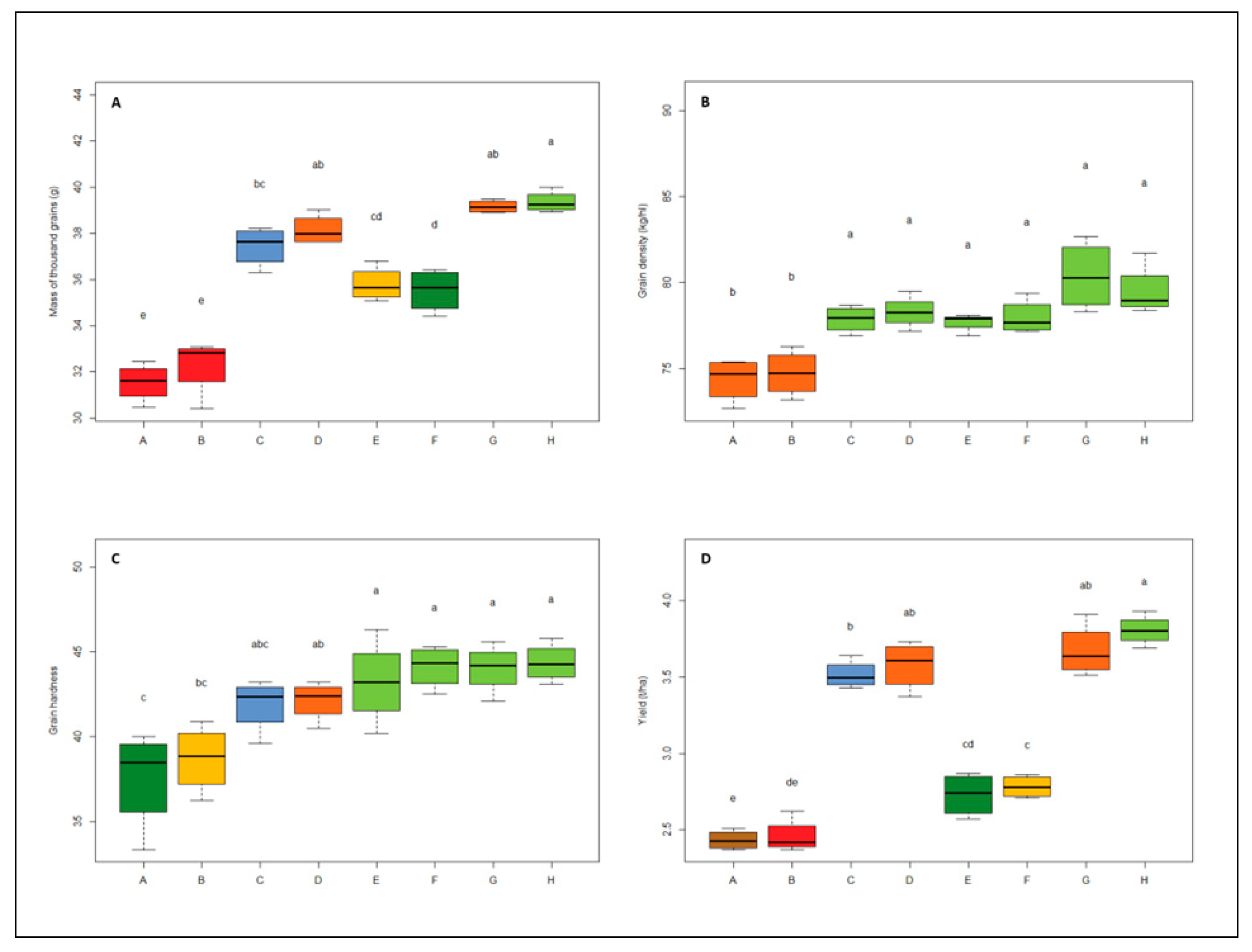
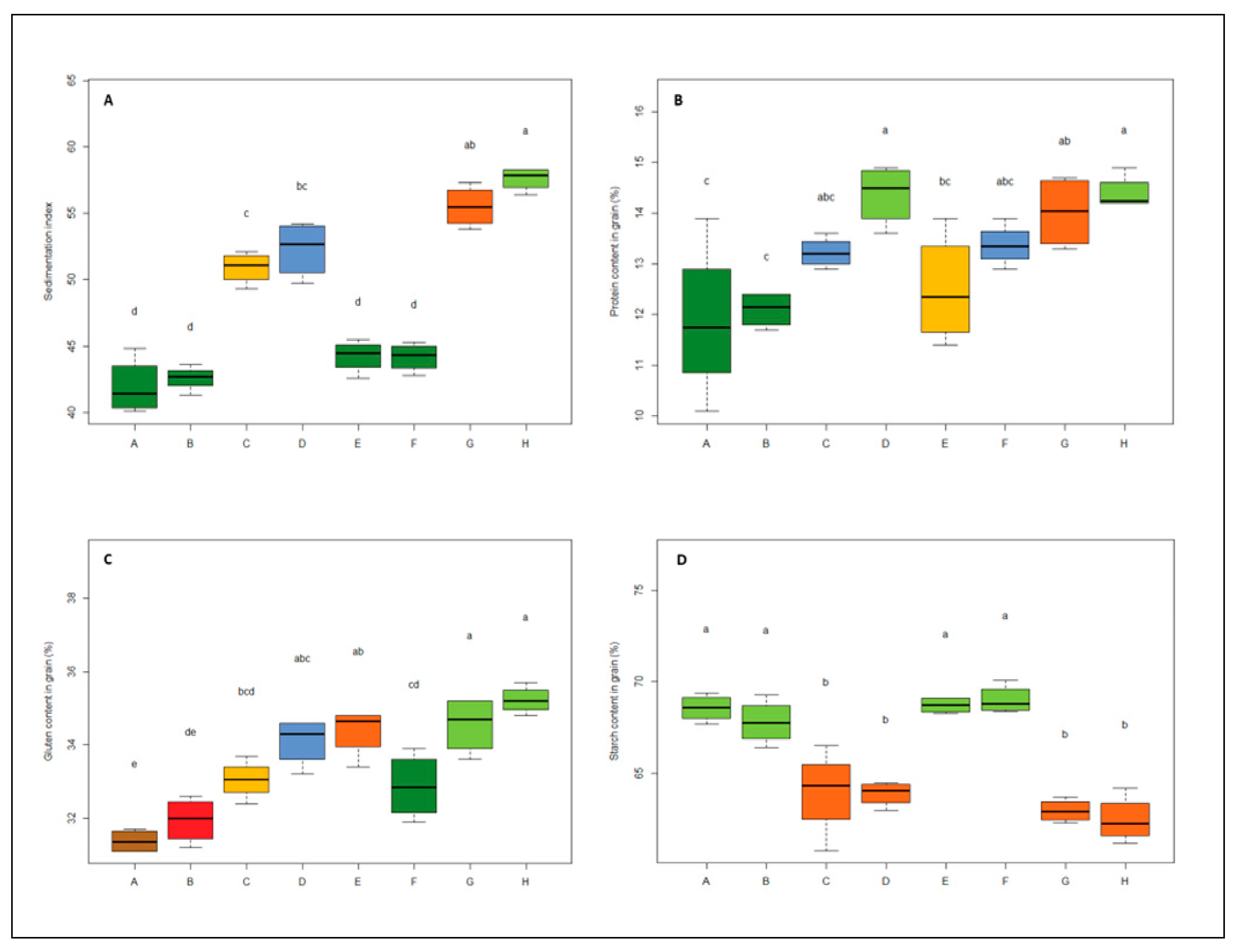
| Year | Month/Decades | |||||||||||
|---|---|---|---|---|---|---|---|---|---|---|---|---|
| April | May | June | ||||||||||
| I | II | III | Mean | I | II | III | Mean | I | II | III | Mean | |
| 2013 | 2.1 | 2.5 | 0.0 | 1.5 | 0.1 | 0.5 | 0.1 | 0.2 | 0 | 0.3 | 0.1 | 0.1 |
| 2014 | 0.1 | 0.1 | 0.2 | 0.1 | 0.4 | 0.4 | 3.2 | 1.3 | 1.9 | 1.3 | 3.7 | 2.3 |
| Experimental Factor | Df | Sum Sq | Mean Sq | F value | Pr (>F) |
|---|---|---|---|---|---|
| Plant height | |||||
| Years | 1 | 570 | 570 | 35.256 | <0.0001 *** |
| Terms of treatment | 2 | 602.2 | 301.1 | 18.623 | <0.0001 *** |
| Concentrations | 1 | 116.3 | 116.3 | 7.192 | 0.0111 * |
| Residuals | 35 | 565.9 | 16.2 | − | − |
| Ear length | |||||
| Years | 1 | 9.604 | 9.604 | 53.75 | <0.0001 *** |
| Terms of treatment | 2 | 3.088 | 1.544 | 8.641 | 0.0009 *** |
| Concentrations | 1 | 0.09 | 0.09 | 0.505 | 0.4818 |
| Residuals | 35 | 6.254 | 0.179 | − | − |
| Chlorophyll content | |||||
| Years | 1 | 2265 | 2265 | 1.512 | 0.227 |
| Terms of treatment | 2 | 68202 | 34101 | 22.758 | <0.0001 *** |
| Concentrations | 1 | 4584 | 4584 | 3.059 | 0.089 |
| Residuals | 35 | 52446 | 1498 | − | − |
| Number of grains per ear | |||||
| Years | 1 | 90.6 | 90.6 | 76.159 | <0.0001 *** |
| Terms of treatment | 2 | 97.75 | 48.88 | 41.085 | <0.0001 *** |
| Concentrations | 1 | 6.39 | 6.39 | 5.372 | 0.0264 * |
| Residuals | 35 | 41.64 | 1.19 | − | − |
| Grain density | |||||
| Years | 1 | 80.37 | 80.37 | 55.411 | <0.0001 *** |
| Terms of treatment | 2 | 62.26 | 31.13 | 21.462 | <0.0001 *** |
| Concentrations | 1 | 0.02 | 0.02 | 0.014 | 0.907 |
| Residuals | 35 | 50.77 | 1.45 | − | − |
| Mass of thousand grains | |||||
| Years | 1 | 240.15 | 240.15 | 228.899 | <0.0001 *** |
| Terms of treatment | 2 | 89.15 | 44.57 | 42.485 | <0.0001 *** |
| Concentrations | 1 | 0.98 | 0.98 | 0.937 | 0.34 |
| Residuals | 35 | 36.72 | 1.05 | − | − |
| Yield | |||||
| Years | 1 | 10.496 | 10.496 | 851.231 | <0.0001 *** |
| Terms of treatment | 2 | 1.07 | 0.535 | 43.405 | <0.0001 *** |
| Concentrations | 1 | 0.037 | 0.037 | 3.011 | 0.0915 |
| Residuals | 35 | 0.432 | 0.012 | − | − |
| Sedimentation index | |||||
| Years | 1 | 1180.5 | 1180.5 | 391.595 | <0.0001 *** |
| Terms of treatment | 2 | 151.4 | 75.7 | 25.108 | <0.0001 *** |
| Concentrations | 1 | 8.3 | 8.3 | 2.754 | 0.106 |
| Residuals | 35 | 105.5 | 3 | − | − |
| Grain hardness index | |||||
| Years | 1 | 31.49 | 31.49 | 9.212 | 0.00452 ** |
| Terms of treatment | 2 | 137.54 | 68.77 | 20.118 | <0.0001 *** |
| Concentrations | 1 | 3.42 | 3.42 | 1 | 0.3241 |
| Residuals | 35 | 119.64 | 3.42 | − | − |
| Protein content in grain | |||||
| Years | 1 | 23.562 | 23.562 | 46.561 | <0.0001 *** |
| Terms of treatment | 2 | 14.27 | 7.135 | 14.1 | <0.0001 *** |
| Concentrations | 1 | 3.445 | 3.445 | 6.808 | 0.0133 * |
| Residuals | 35 | 17.712 | 0.506 | − | − |
| Gluten content in grain | |||||
| Years | 1 | 30.62 | 30.625 | 44.664 | <0.0001 *** |
| Terms of treatment | 2 | 37.58 | 18.79 | 27.404 | <0.0001 *** |
| Concentrations | 1 | 0.32 | 0.32 | 0.467 | 0.499 |
| Residuals | 35 | 24 | 0.686 | − | − |
| Starch content in grain | |||||
| Years | 1 | 246.41 | 246.41 | 172.973 | <0.0001 *** |
| Terms of treatment | 2 | 14.25 | 7.13 | 5.002 | 0.0123 * |
| Concentrations | 1 | 0.56 | 0.56 | 0.393 | 0.5351 |
| Residuals | 35 | 49.86 | 1.42 | − | − |
| Trait | Concentration | Term of Application | Year | |||||
|---|---|---|---|---|---|---|---|---|
| Control | ASA3 mM | ASA5 mM | Control | T1/T2 | T3/T4 | 2013 | 2014 | |
| Plant height (cm) | 70.75 ± 6.63 c | 77.75 ± 6.36 b | 81.56 ± 4.59 a | 70.75 ± 6.63 b | 77.94 ± 5.76 a | 81.38 ± 5.46 a | 74.10 ± 6.23 b | 81.65 ± 5.36 a |
| Ear length (cm) | 8.56 ± 0.71 a | 8.82 ± 0.75 a | 8.93 ± 0.66 a | 8.56 ± 0.71 b | 8.59 ± 0.72 b | 9.15 ± 0.55 a | 8.32 ± 0.59 b | 9.30 ± 0.38 a |
| Chlorophyll content (SPAD) | 470.8 ± 63.64 b | 556.6 ± 35.83 a | 580.6 ± 30.59 a | 470.8 ±63.64 b | 553.9 ± 37.84 a | 583.3 ± 25.12 a | 541.5 ± 74.67a | 556.6 ± 31.86 a |
| Number of grains per ear (pcs.) | 24.6 ± 1.62 b | 26.8 ± 2.27 a | 27.7 ± 2.43 a | 24.6 ± 1.62 c | 26.0 ± 2.15 b | 28.6 ± 1.84 a | 25.2 ± 2.01 b | 28.3 ± 1.91 a |
| Mass of thousand grains (g) | 33.81 ± 3.16 b | 35.97 ± 2.99 a | 36.33 ± 2.91 a | 33.81 ± 3.16 b | 34.85 ± 3.17 b | 37.45 ± 1.95 a | 33.23 ± 2.29 b | 38.13 ± 1.19 a |
| Grain density (kg·hl–1) | 76.4 ± 1.84 a | 77.6 ± 2.49 a | 77.6 ± 2.12 a | 76.4 ± 1.84 b | 76.3 ± 2.08 b | 78.9 ± 1.68 a | 76.0 ± 1.90 b | 78.8 ± 1.52 a |
| Grain hardness index | 40.31 ± 0.92 b | 41.67 ± 3.25 ab | 42.32 ± 2.66 a | 40.31 ± 0.92 b | 40.07 ± 2.73 b | 43.93 ± 1.56 a | 40.78 ± 3.20 b | 42.55 ± 1.86 a |
| Yield (t·ha–1) | 2.83 ± 0.52 b | 3.09 ± 0.55 a | 3.16 ± 0.58 a | 2.83 ± 0.51 c | 3.00 ± 0.58 b | 3.25 ± 0.52 a | 2.55 ± 0.20 b | 3.57 ± 0.20 a |
| Sedimentation index | 45.70 ± 6.21 b | 48.14 ± 5.73 a | 49.16 ± 6.43 a | 45.70 ± 6.21 b | 46.93 ± 5.09 b | 50.38 ± 6.51 a | 42.63 ± 2.03 b | 53.49 ± 3.13 a |
| Protein content in grain (%) | 11.95 ± 0.88 c | 12.91 ±1.24 b | 13.56 ± 1.05 a | 11.95 ± 0.88 c | 12.89 ± 1.29 b | 13.58 ± 0.98 a | 12.21 ± 1.10 b | 13.75 ± 0.81 a |
| Gluten content in grain (%) | 31.85 ± 1.51 b | 33.34 ± 1.42 a | 33.54 ± 1.41 a | 31.85 ± 1.51 b | 32.62 ± 1.19 b | 34.26 ± 1.09 a | 32.25 ± 1.43 b | 34.00 ± 1.10 a |
| Starch content in grain (%) | 67.39 ± 2.34 a | 66.06 ± 2.94 b | 65.80 ± 2.93 b | 67.39 ± 2.34 a | 66.07 ± 2.55 b | 65.79 ± 3.28 b | 68.71 ± 1.01 b | 63.74 ± 1.54 a |
Publisher’s Note: MDPI stays neutral with regard to jurisdictional claims in published maps and institutional affiliations. |
© 2020 by the authors. Licensee MDPI, Basel, Switzerland. This article is an open access article distributed under the terms and conditions of the Creative Commons Attribution (CC BY) license (http://creativecommons.org/licenses/by/4.0/).
Share and Cite
Matysiak, K.; Siatkowski, I.; Kierzek, R.; Kowalska, J.; Krawczyk, R. Effect of Foliar Applied Acetylsalicilic Acid on Wheat (Triticum aestivum L.) under Field Conditions. Agronomy 2020, 10, 1918. https://doi.org/10.3390/agronomy10121918
Matysiak K, Siatkowski I, Kierzek R, Kowalska J, Krawczyk R. Effect of Foliar Applied Acetylsalicilic Acid on Wheat (Triticum aestivum L.) under Field Conditions. Agronomy. 2020; 10(12):1918. https://doi.org/10.3390/agronomy10121918
Chicago/Turabian StyleMatysiak, Kinga, Idzi Siatkowski, Roman Kierzek, Jolanta Kowalska, and Roman Krawczyk. 2020. "Effect of Foliar Applied Acetylsalicilic Acid on Wheat (Triticum aestivum L.) under Field Conditions" Agronomy 10, no. 12: 1918. https://doi.org/10.3390/agronomy10121918
APA StyleMatysiak, K., Siatkowski, I., Kierzek, R., Kowalska, J., & Krawczyk, R. (2020). Effect of Foliar Applied Acetylsalicilic Acid on Wheat (Triticum aestivum L.) under Field Conditions. Agronomy, 10(12), 1918. https://doi.org/10.3390/agronomy10121918






